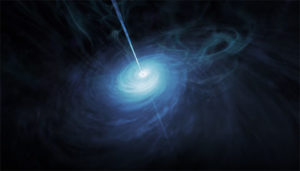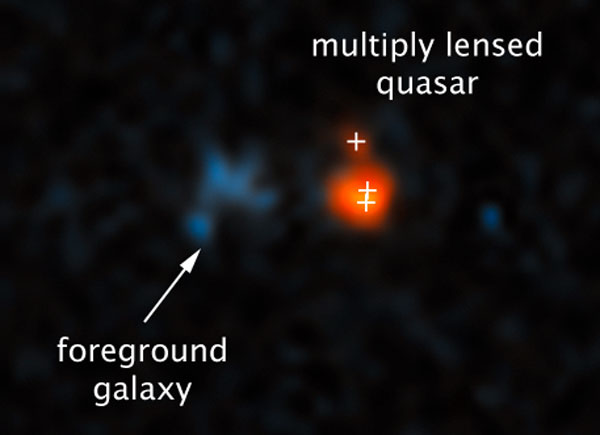The most distant magnified quasar known promises to shed light on the universe's early years.

ESA / Hubble / NASA / M. Kornmesser
A cosmic lens has magnified light from a distant quasar, making it shine with brightness of 600 trillion Suns, astronomers report in a study published in the January 9th Astrophysical Journal Letters. That makes it “the brightest object in cosmic dawn,” says study author Xiaohui Fan (University of Arizona), and it’s giving astronomers an unprecedented look at the formation of supermassive black holes and their galaxies in the early universe.
A quasar is a supermassive black hole that devours gas in its vicinity and releases huge amounts of energy in the process. Quasars are thus one of the few sources visible from billions of light-years away, all the way back to when the universe was forming its first stars, an era known as the Epoch of Reionization. Hundreds of quasars are known at these large distances, but to be seen from so far away, they must be unusually bright, and therefore unusually massive.
How do quasars become so massive so early on? Some theorists argued they might not actually be that massive — a large fraction of them could be gravitationally lensed, aligned right behind an intervening galaxy that acts as a cosmic telescope to boost the quasar’s brightness. Yet no lensed quasars had been found in the early universe, and no one was quite sure why. (Previously, the most distant lensed quasars known existed 1.2 billion years after the Big Bang, well after reionization had ended.)
That’s why, even as Fan and colleagues analyzed survey data searching for luminous quasars, they were surprised when the quasar designated UHS J043947.08+163415.7 caught their eye. “We saw it was very bright — the brightest discovered in the universe,” says coauthor Fabio Pacucci (Yale University). It was so bright, in fact, that its luminosity initially implied a 10 billion solar mass black hole, which would have been a truly surprising result.
The scientists followed up on the odd object using a number of large-aperture telescopes, including the MMT 6.5-meter telescope in Arizona and the 10-meter Keck telescope in Hawai‘i.. The source’s spectrum held another surprise. Because the quasar is so far away, its wavelengths should have stretched as they traveled through the expanding universe, redshifting their light. However, the spectrum showed a faint blue signature as well. The blue light contaminating the light could have come from a foreground object, Fan says, but groundbased images couldn’t discern what it was.
So the team took to the skies, looking at the quasars again with the Hubble Space Telescope. The sharp Hubble photos resolved the light into multiple sources: a faint blur from a foreground galaxy and multiple sources that are all from the same quasar, whose light split as it passed around the nearer galaxy. The foreground galaxy sits about halfway between us and the quasar, and magnifies the quasar’s light by a factor of 50. Light from the quasar itself has traveled 12.9 billion years to reach Earth.

NASA / ESA / X. Fan (University of Arizona)
Finding a gravitationally lensed quasar only 850 million years after the Big Bang is a major discovery, says Pacucci. To be sure, scientists had been looking for such quasars for almost two decades.
Yet, as Fan emphasized in a presentation at the American Astronomical Society meeting last week in Seattle, “It was a serendipitous discovery — we didn’t set out to find this object.”
“This quasar is magnified by 50 times, but there must be quasars magnified by less,” adds Avi Loeb (Harvard-Smithsonian Center for Astrophysics), who wrote a follow-up paper with Pacucci on the study’s implications. “There should be many more [distant gravitationally lensed quasars] that were missed.” Now scientists know better what to look for to find these rare alignments.
In addition to finding new lenses on the cosmic dawn, Fan’s team plans detailed followup on the newly discovered quasar. Millimeter-wavelength observations from the Atacama Large Millimeter/submillimeter Array (ALMA) in Chile, for example, will allow astronomers to see details in the quasar’s host galaxy and around the central black hole that are just 150 light-years across — an amazing feat for something so far away!
Reference:
X. Fan et al. "The Discovery of a Gravitationally Lensed Quasar at z = 6.51." Astrophysical Journal Letters, 2019 January 9. (Full preprint)
 1
1









Comments
fif52
February 3, 2019 at 7:24 pm
isn't this too large to be a quasar? gravitationally lensing a useful quantity, has appeared before increasing the size of a perceived object from beyond current capabilities to within.
You must be logged in to post a comment.
You must be logged in to post a comment.